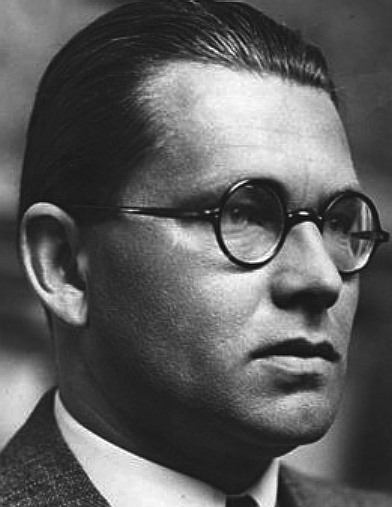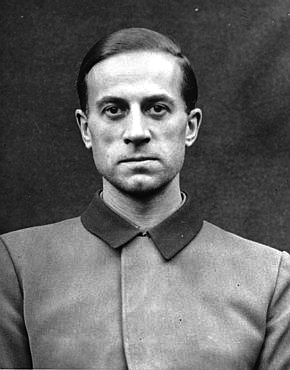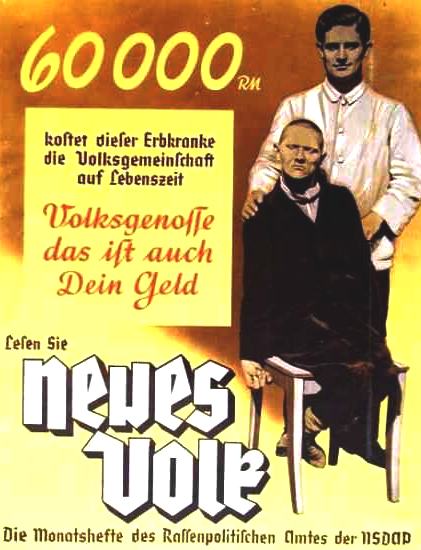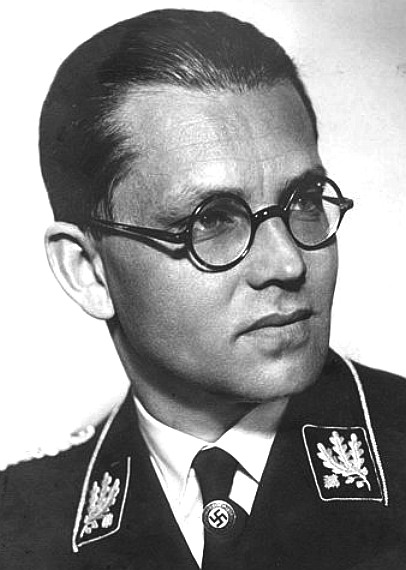|
Eugenics is the "applied science or the bio-social movement which advocates the use of practices aimed at improving the genetic composition of a population", usually referring to the manipulation of human
populations. The origins of the concept of eugenics began with certain interpretations of Mendelian inheritance, and the theories of August
Weismann. Historically, many of the practitioners of eugenics viewed eugenics as a science, not necessarily restricted to human populations; this embraced the views of Darwinism and Social
Darwinism.

The
ultimate population
controller?
Eugenics was widely popular in the early decades of the 20th
century. The First International Congress of Eugenics in 1912 was supported by many prominent persons, including: its president Leonard Darwin, the son of Charles Darwin; honorary vice-president Winston Churchill, then First Lord of the Admiralty and future Prime Minister of the United Kingdom; Auguste Forel, famous Swiss pathologist; Alexander Graham Bell, the inventor of the telephone; among other prominent
people.
Eugenics was a controversial concept even shortly after its
creation. The first major challenge to eugenics was made in 1915 by Thomas Hunt Morgan, who demonstrated the event of genetic mutation occurring outside of inheritance involving the discovery of the birth of a fruit fly with white eyes from a family and ancestry of the red-eyed Drosophila melanogaster species of fruit
fly. Morgan claimed that this demonstrated that major genetic changes occurred outside of inheritance and that the concept of eugenics based upon genetic inheritance was severely
flawed.
By the mid-20th century eugenics had fallen into disfavor, having become associated with Nazi Germany. This country's approach to genetics and eugenics was focused on Eugen Fischer's concept of
phenogenetics and the Nazi twin study methods of Fischer and Otmar Freiherr von Verschuer. Both the public and some elements of the scientific community have associated eugenics with Nazi abuses, such as enforced
"racial hygiene", human experimentation, and the extermination of "undesired" population groups. However, developments in genetic, genomic, and reproductive technologies at the end of the 20th century have raised many new questions and concerns about the meaning of eugenics and its ethical and moral status in the modern era, effectively creating a resurgence of interest in eugenics.

Philipp Bouhler,
Nazi T4 eugenicist
Overview
As a social movement, eugenics reached its greatest popularity in the early decades of the 20th century. By the end of World War II eugenics had been largely
abandoned. Although current trends in genetics have raised questions amongst critical academics concerning parallels between pre-war attitudes about eugenics and current "utilitarian" and social theories allegedly related to
Darwinism, they are, in fact, only superficially related and somewhat contradictory to one
another. At its pre-war height, the movement often pursued pseudoscientific notions of racial supremacy and
purity.
Eugenics was practiced around the world and was promoted by governments, and influential individuals and institutions. Its advocates regarded it as a social philosophy for the improvement of
human hereditary traits through the promotion of higher reproduction of certain people and traits, and the reduction of reproduction of other people and
traits.
Today it is widely regarded as a brutal movement which inflicted massive human rights violations on millions of
people. The "interventions" advocated and practiced by eugenicists involved prominently the identification and classification of individuals and their families, including the poor, mentally ill, blind, deaf, developmentally disabled, promiscuous women, homosexuals and entire racial groups — such as the Roma and Jews — as "degenerate" or "unfit"; the segregation or institutionalisation of such individuals and groups, their sterilization, euthanasia, and in the extreme case of Nazi Germany, their mass
extermination.
The practices engaged in by eugenicists involving violations of privacy, attacks on reputation, violations of the right to life, to found a family, to freedom from discrimination are all today classified as violations of
human rights. The practice of negative racial aspects of eugenics, after
World War II, fell within the definition of the new international crime of genocide, set out in the Convention on the Prevention and Punishment of the Crime of
Genocide.

Dr. Karl Brandt, Hitler's personal physician, eugenicist and organizer of Action
T4
The modern field and term were first formulated by Sir Francis Galton in
1883, drawing on the recent work of his half-cousin Charles
Darwin. At its peak of popularity eugenics was supported by a wide variety of prominent people, including
Winston Churchill, Margaret
Sanger, Marie Stopes, H. G. Wells, Theodore Roosevelt, George Bernard Shaw, John Maynard Keynes, John Harvey Kellogg, Linus
Pauling and Sidney Webb. Many members of the American Progressive Movement supported eugenics, seduced by its scientific trappings and its promise of a quick end to social ills. Its most infamous proponent and practitioner was, however, Adolf Hitler who praised and incorporated eugenic ideas in Mein Kampf and emulated Eugenic legislation for the sterilization of "defectives" that had been pioneered in the
United
States.
The American sociologist Lester Frank Ward and the English writer G. K. Chesterton were early critics of the philosophy of eugenics. Ward's 1913 article "Eugenics, Euthenics, and
Eudemics" and Chesterton's 1917 book Eugenics and Other Evils were harshly critical of the rapidly growing eugenics movement.

Eugenics became an academic discipline at many colleges and universities, and received funding from many
sources. Three International Eugenics Conferences presented a global venue for eugenicists with meetings in 1912 in
London, and in 1921 and 1932 in New York. Eugenic policies were first implemented in the early 1900s in the United
States. Later, in the 1920s and 30s, the eugenic policy of sterilizing certain mental patients was implemented in a variety of other countries, including
Belgium, Brazil, Canada, and Sweden, among others. The scientific reputation of eugenics started to decline in the 1930s, a time when Ernst Rüdin used eugenics as a justification for the racial policies of Nazi Germany, and when proponents of eugenics among scientists and thinkers prompted a backlash in the public. Nevertheless, in
Sweden the eugenics program continued until
1975.
Since the postwar period, both the public and the scientific communities have associated eugenics with Nazi abuses, such as enforced racial hygiene, human experimentation, and the extermination of "undesired" population groups. However, developments in genetic, genomic, and reproductive technologies at the end of the 20th century have raised many new questions and concerns about what exactly constitutes the meaning of eugenics and what its ethical and moral status is in the modern era.
Population
control & Malthusian supporters - Youtube
Germany
and Nazi eugenics
Josef Mengele
Nazi propaganda for their compulsory "euthanasia" program: "This person suffering from hereditary defects costs the community 60,000 Reichsmark during his lifetime. Fellow German, that is your money, too."

Philipp Bouhler, Head of the T4 programme
Nazi Germany under Adolf Hitler was well known for eugenics programs which attempted to maintain a "pure" German race through a series of programs that ran under the banner of racial hygiene. Among other activities, the Nazis performed extensive experimentation on live human beings to test their genetic theories, ranging from simple measurement of physical characteristics to the research for Otmar von Verschuer carried out by Karin Magnussen using "human material" gathered by Josef Mengele on twins and others at Auschwitz death
camp. During the 1930s and 1940s, the Nazi regime forcibly sterilized hundreds of thousands of people whom they viewed as mentally and physically unfit, an estimated 400,000 between 1934 and 1937. The scale of the Nazi program prompted one American eugenics advocate to seek an expansion of their program, with one complaining that "the Germans are beating us at our own
game."
"We do not stand alone": Nazi poster from 1936 with flags of other countries
with, or considering introducing, compulsory sterilization legislation.
The Nazis went further, however, killing tens of thousands of the institutionalized disabled through compulsory "euthanasia" programs such as Aktion
T4.
They also implemented a number of positive eugenics policies, giving awards to Aryan women who had large numbers of children and encouraged a service in which "racially pure" single women could deliver illegitimate children. Allegations that such women were also impregnated by SS officers in the Lebensborn were not proven at the Nuremberg trials, but new evidence (and the testimony of Lebensborn children) has established more details about
Lebensborn
practices. Also, "racially valuable" children from occupied countries were forcibly removed from their parents and adopted by German people. Many of their concerns for eugenics and racial hygiene were also explicitly present in their systematic killing of millions of "undesirable" people, especially Jews who were singled out for the Final Solution, this policy led to the horrors seen in the
Holocaust.
The scope and coercion involved in the German eugenics programs along with a strong use of the rhetoric of eugenics and so-called "racial science" throughout the regime created an indelible cultural association between eugenics and the Third Reich in the post-war
years.
Germany
WWII
Two scholars, John Glad and Seymour W. Itzkoff of Smith College, have questioned the relation between eugenics and the Holocaust. They argue that, contrary to popular belief, Hitler did not regard the Jews as intellectually inferior and did not send them to the concentration camps on these grounds. They argue that Hitler had different reasons for his genocidal policies toward the
Jews. Seymour W. Itzkoff writes that the Holocaust was "a vast dysgenic program to rid
Europe of highly intelligent challengers to the existing
Christian domination by a numerically and politically minuscule minority". Therefore, according to Itzkoff, "the Holocaust was the very antithesis of eugenic
practice".
The ideas of eugenics and race were used, in part, as justification for German colonial expansion throughout the world. Germany, as well as Great Britain, sought to seize the colonial territories of other 'dying' empires which could no longer protect their possessions. Examples included
China, the Portuguese Empire, the Spanish Empire, the
Dutch Empire and the Danish Empire.
"Thus the colonies Germany required for her bursting population, as markets for her
over-productive industries and sources of vital raw materials, and as symbols of her world power would simply have to be taken from weaker nations, so the pan-Germans asserted publicly and the German government believed
secretly." This is of course nothing new, the Romans took
over Cleopatra's Egypt for
exactly the same reason: grain.
|
John
Storm and the
Cyber Wars
In
1945 Adolf Hitler refuses to accept defeat in the face
of the advancing allied forces. He's tried the V1 flying
bomb and V2 rocket, but failed to deliver a nuclear
strike. He may have lost this battle, but he has a plan
up his sleeve for world supremacy that the allies could
not possibly foresee.
Over
70 years will pass before Hitler's
terrible scheme begins to see results .
This novel delves deep into the technology that is
available today, that could begin the unstoppable
takeover, or world domination that Adolf and his
followers could only dream about - if it got into the
wrong hands.


|
EXPERIMENTS:
Adolf
Hitler
Cloning
Concentration
Camps
Eugenics
Human
Genome Project
Lebensborn
The
4th Reich
World
War Three
LINKS:
Eugenics
Archive – Historical Material on the Eugenics Movement
University
of Virginia Historical Collections: Eugenics
"Deadly
Medicine: Creating the Master Race" (United States Holocaust Memorial
Museum exhibit)
"Controlling
Heredity: The American Eugenics Crusade, 1870-1940
"Eugenics"
– National Reference Center for Bioethics Literature
1907
Indiana Eugenics Law
THIS
PAGE IS UNDER DEVELOPMENT
OTHER
ANIMALS:
A
taste for adventure capitalists

Solar
Cola - the healthier cola alternative
|






